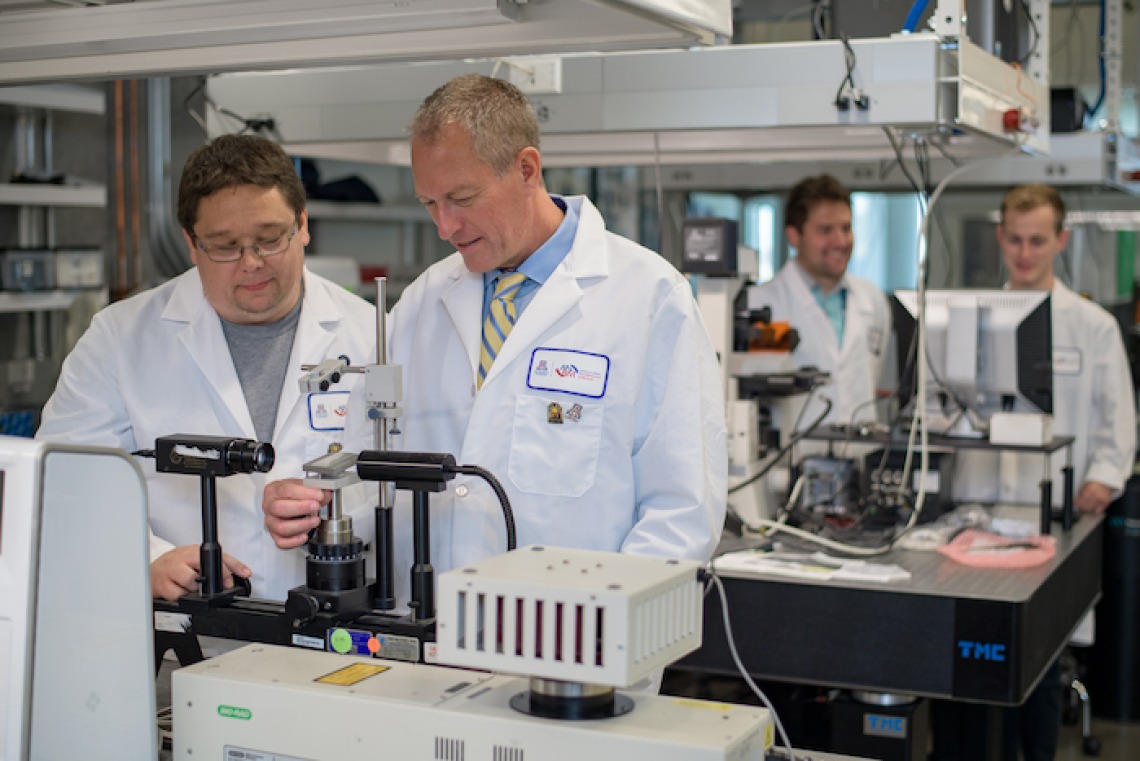Researcher's Work Enables Simpler Detection of Radiation Exposure Risk

Frederic Zenhausern, right, professor and director of the Center for Applied NanoBioscience and Medicine, works in his lab with Matthew Barrett, a senior research specialist. (Photo courtesy of the College of Medicine – Phoenix)
Frederic Zenhausern, professor and director of the Center for Applied NanoBioscience and Medicine at the College of Medicine – Phoenix, has done pioneering work in microfluidics, genetics and DNA forensics.
His work in rapid DNA analysis was implemented by the FBI, the U.K. Forensic Science Services, and police forces in the U.K., the Netherlands, Germany and Austria. The mobility at the point of care and the acceleration of the analytical turnaround time from days to less than one hour provided a significant reduction in the processing backlog of sexual assault cases.
With the passage of the Rapid DNA Act of 2017, the technology became available an effective tool for law enforcement, but also promising for point-of-care diagnostics in clinical settings.
Zenhausern holds more than 20 U.S. patents for DNA sequencing, organ-on-a-chip and genomic analysis and was active in technology licensing with industry. In addition to point-of-care diagnostic instrumentation and biosensors for protection against chemical, biological, radiological and nuclear threats, Zenhausern has made discoveries in the areas of high-resolution microscopy, near-field optics and spectroscopy.
Zenhausern recently discussed his latest work.
Please explain your research.
ANBM (Applied NanoBioscience and Medicine) has received three independent NASA grants. The latest funding will allow researchers to develop a diagnostic tool – a miniature syringe-like device that can detect bio-agents and hundreds of biomarkers in blood or saliva – and test it in space.
This is the next step in the evolution of this technology toward use on a test flight in space. The "vertical flow" device, a novel technology patented and licensed by Tech Launch Arizona, is being used as an easy way to test astronauts' health in space.
In the center's first NASA grant, the chemistry of the device was tested for protein markers. Its application to nucleic acid detection was demonstrated under a second NASA Human Research Program grant, led by center researcher Jerome Lacombe, an assistant scientific investigator and assistant research professor in the medical school's Department of Basic Medical Sciences.
The latest grant is for $100,000 from NASA and its Translational Research Institute for Space Health. With the grant, the center and Space Tango, a private aerospace company that designs, builds and operates facilities on the International Space Station, will work to develop the diagnostic test using a human factor engineering approach to validate its performance in microgravity.
Center researcher Jian Gu, an assistant scientific investigator and assistant research professor in the Department of Basic Medical Sciences, will work with the Kentucky-based company to integrate the diagnostic platform into Space Tango's automated hardware.
Why is this important?
NASA is investing more funds in space exploration and is considering human health as its first priority to succeed in long-duration missions. Until now, very little monitoring of the health of astronauts has occurred, but deep space travel will require cutting-edge technologies for astronaut health and performance.
What is your motivation for this next-generation immunoassay technology?
I often go biking in the mountains near my home in Fountain Hills, Arizona. Being alone in remote areas made me realize that time is of the utmost importance during a medical emergency or after exposure to a biological threat in remote settings. Having access to robust, simple, low-cost biomedical platform technologies compatible with modern communication systems such as smartphones offers a sense of protection and lifestyle management to prioritize health and ultimately improve quality of life.
Why now?
There is a need for disruptive innovation in health care delivery. This technology allows for more mobile access to care, earlier disease detection and advances personalized and precision diagnostics and treatments.
A version of this article originally appeared on the College of Medicine – Phoenix website.

